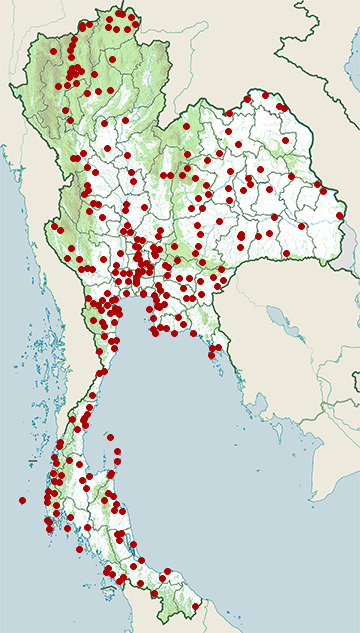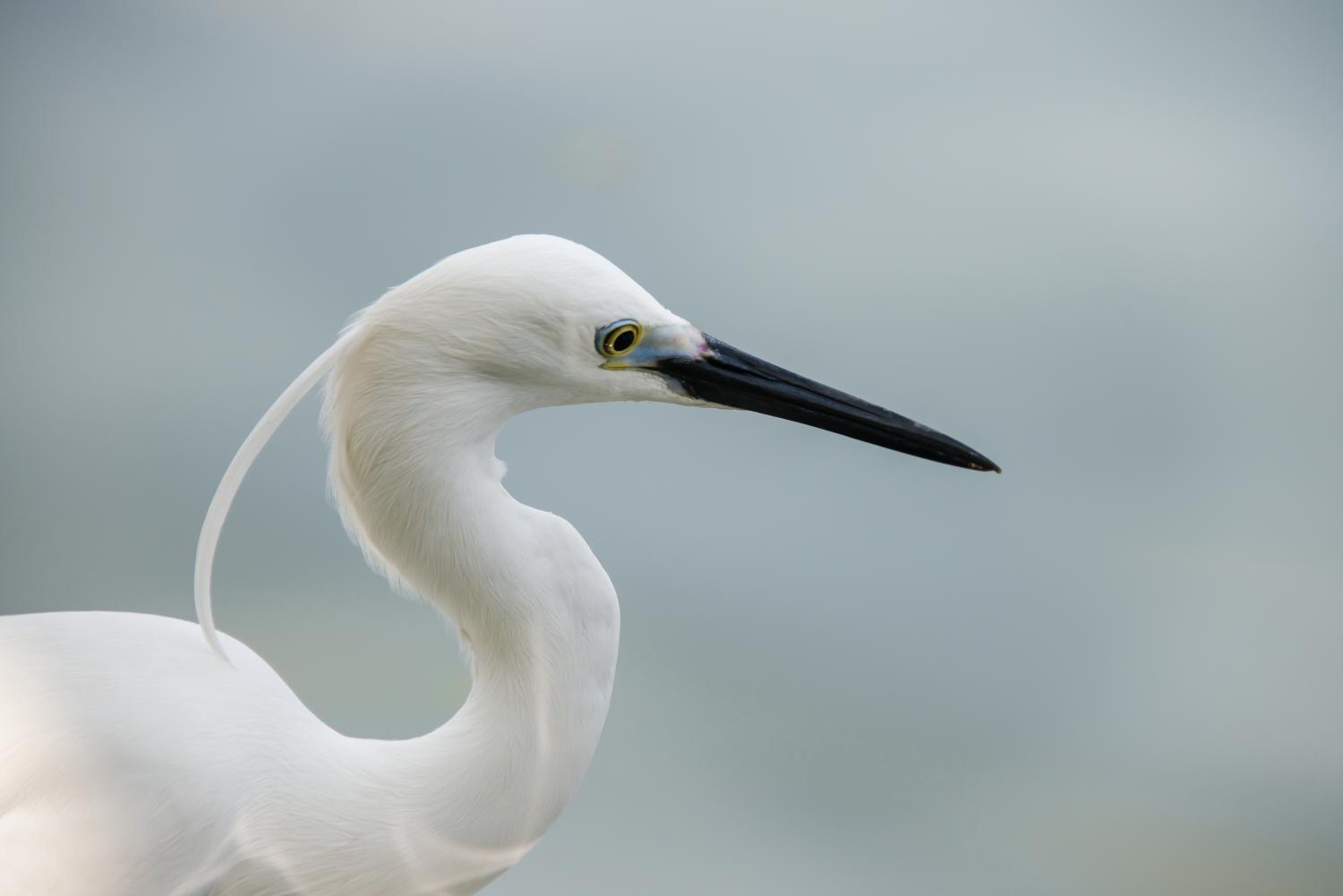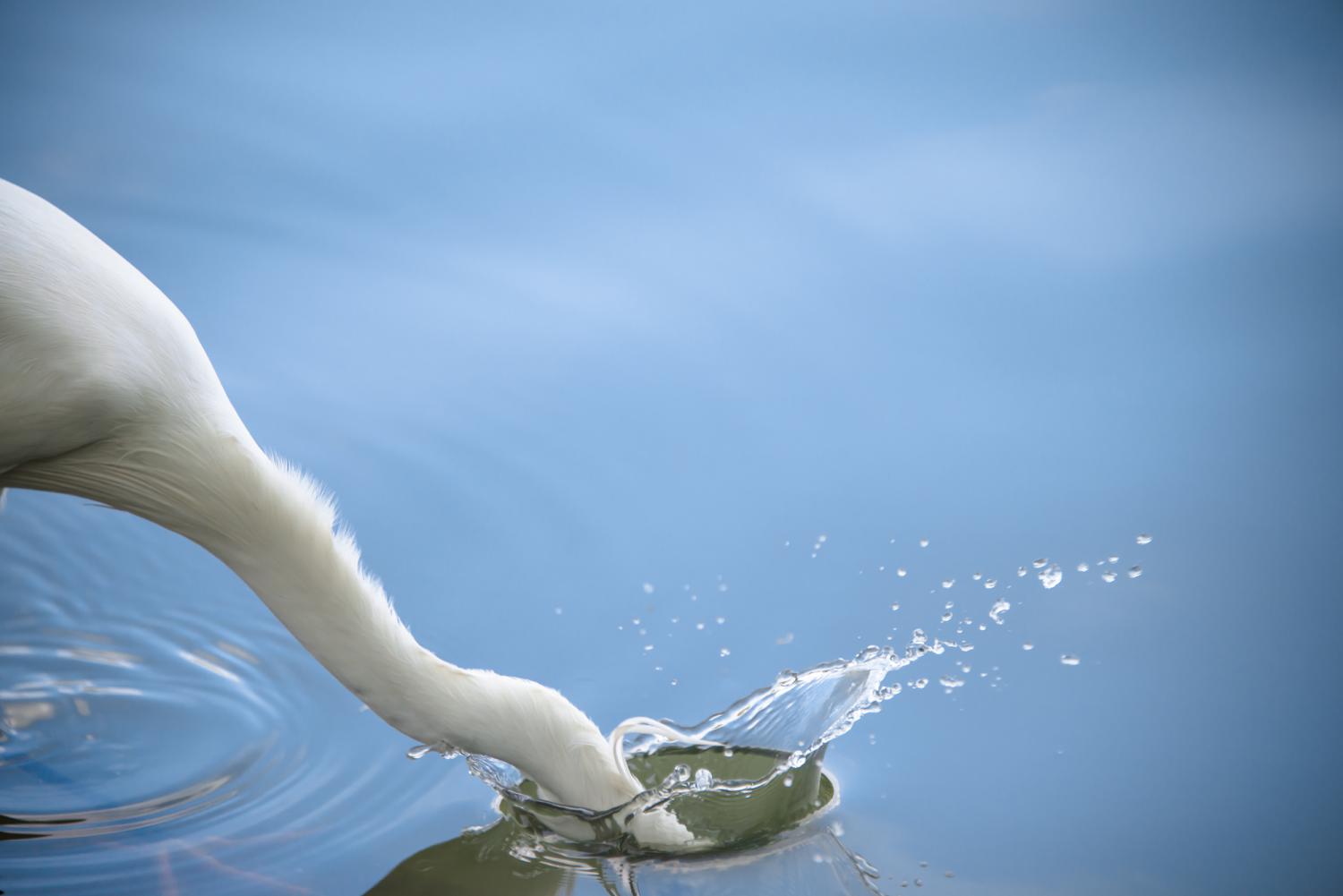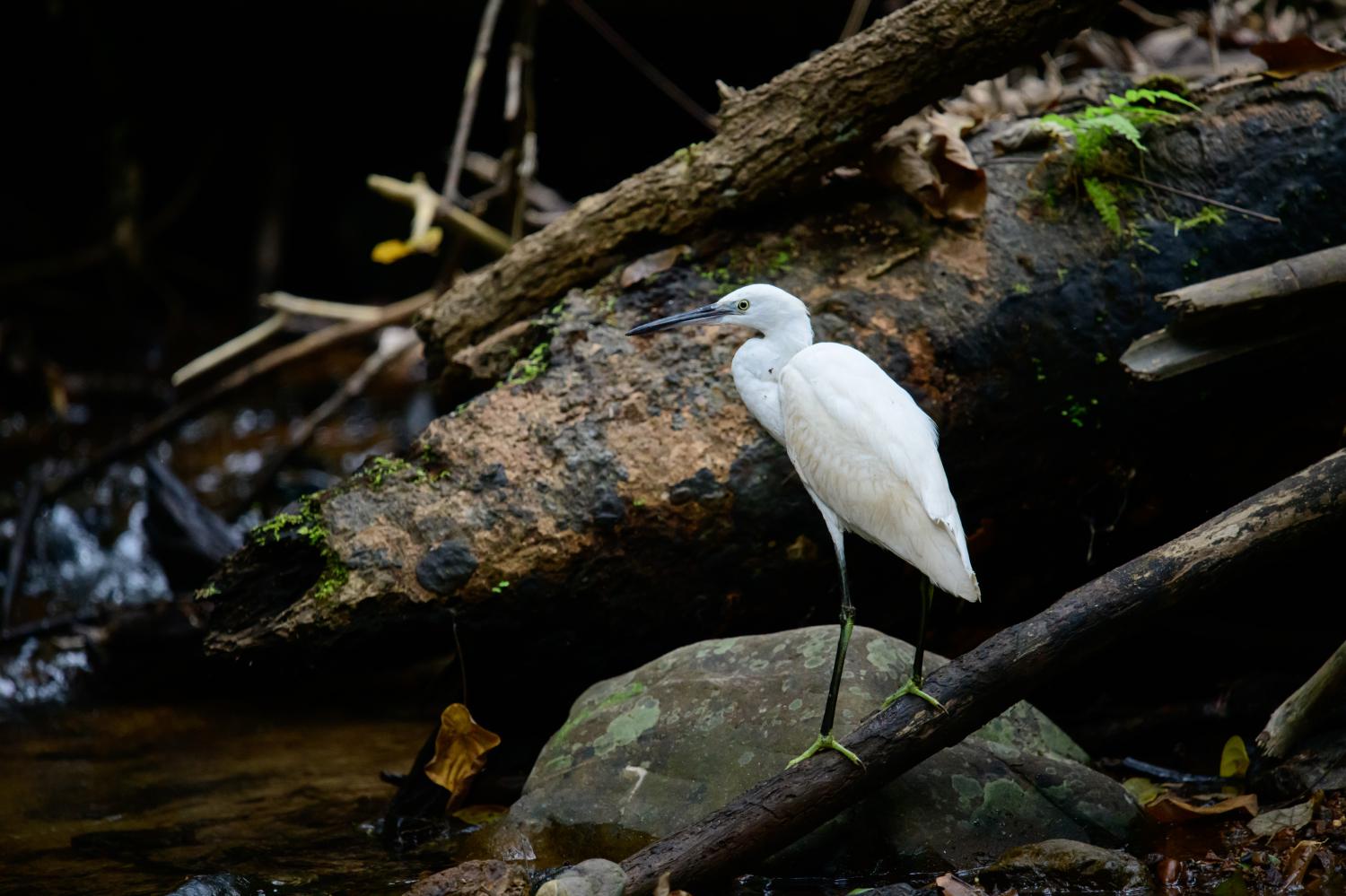Species of Thailand
Little egret
Egretta garzetta
Carolus Linnaeus, 1766
In Thai: นกยางเปีย
The little egret (Egretta garzetta) is a species of small heron in the family Ardeidae. The genus name comes from the Provençal French Aigrette, "egret", a diminutive of Aigron, " heron". The species epithet garzetta is from the Italian name for this bird, garzetta or sgarzetta.
It is a white bird with a slender black beak, long black legs and, in the western race, yellow feet. As an aquatic bird, it feeds in shallow water and on land, consuming a variety of small creatures. It breeds colonially, often with other species of water birds, making a platform nest of sticks in a tree, bush or reed bed. A clutch of three to five bluish-green eggs is laid and incubated by both parents for about three weeks. The young fledge at about six weeks of age.
Its breeding distribution is in wetlands in warm temperate to tropical parts of Europe, Africa, Asia, and Australia. A successful colonist, its range has gradually expanded north, with stable and self-sustaining populations now present in the United Kingdom.
In warmer locations, most birds are permanent residents; northern populations, including many European birds, migrate to Africa and southern Asia to over-winter there. The birds may also wander north in late summer after the breeding season, and their tendency to disperse may have assisted in the recent expansion of the bird's range. At one time common in Western Europe, it was hunted extensively in the 19th century to provide plumes for the decoration of hats and became locally extinct in northwestern Europe and scarce in the south. Around 1950, conservation laws were introduced in southern Europe to protect the species and their numbers began to increase. By the beginning of the 21st century the bird was breeding again in France, the Netherlands, Ireland and Britain. Its range is continuing to expand westward, and the species has begun to colonise the New World; it was first seen in Barbados in 1954 and first bred there in 1994. The International Union for Conservation of Nature has assessed the bird's global conservation status as being of "least concern".
Subspecies
Depending on authority, two or three subspecies of little egret are currently accepted:
- E. g. garzetta – (Linnaeus, 1766): nominate, found in Europe, Africa, and most of Asia except the south-east
- E. g. nigripes – (Temminck, 1840): found in Indonesia east to New Guinea
- E. g. immaculata – Australia and (non-breeding) New Zealand, often considered synonymous with E. g. nigripes
Three other egret taxa have at times been classified as subspecies of the little egret in the past but are now regarded as two separate species. These are the western reef heron Egretta gularis which occurs on the coastline of West Africa (Egretta gularis gularis) and from the Red Sea to India (Egretta gularis schistacea), and the dimorphic egret Egretta dimorpha, found in East Africa, Madagascar, the Comoros and the Aldabra Islands.
Description
The adult little egret is 55 – 65 cm long with an 88 – 106 cm wingspan, and weighs 350 – 550 g. Its plumage is normally entirely white, although there are dark forms with largely bluish-grey plumage. In the breeding season, the adult has two long plumes on the nape that form a crest. These plumes are about 150 mm and are pointed and very narrow. There are similar feathers on the breast, but the barbs are more widely spread. There are also several elongated scapular feathers that have long loose barbs and may be 200 mm long. During the winter the plumage is similar but the scapulars are shorter and more normal in appearance. The bill is long and slender and it and the lores are black. There is an area of greenish-grey bare skin at the base of the lower mandible and around the eye which has a yellow iris. The legs are black and the feet yellow. Juveniles are similar to non-breeding adults but have greenish-black legs and duller yellow feet, and may have a certain proportion of greyish or brownish feathers. The subspecies nigripes differs in having yellow skin between the bill and eye, and blackish feet. During the height of courtship, the lores turn red and the feet of the yellow-footed races turn red.
Little egrets are mostly silent but make various croaking and bubbling calls at their breeding colonies and produce a harsh alarm call when disturbed. To the human ear, the sounds are indistinguishable from the black-crowned night heron (Nycticorax nycticorax) and the cattle egret (Bubulcus ibis) with which it sometimes associates.
Distribution and habitat
The breeding range of the western race (E. g. garzetta) includes southern Europe, the Middle East, much of Africa and southern Asia. Northern European populations are migratory, mostly travelling to Africa although some remain in southern Europe, while some Asian populations migrate to the Philippines. The eastern race, (E. g. nigripes), is resident in Indonesia and New Guinea, while E. g. immaculata inhabits Australia and New Zealand, but does not breed in the latter. During the late twentieth century, the range of the little egret expanded northwards in Europe and into the New World, where a breeding population was established on Barbados in 1994. The birds have since spread elsewhere in the Caribbean region and on the Atlantic coast of the United States.
The little egret's habitat varies widely, and includes the shores of lakes, rivers, canals, ponds, lagoons, marshes and flooded land, the bird preferring open locations to dense cover. On the coast it inhabits mangrove areas, swamps, mudflats, sandy beaches and reefs. Rice fields are an important habitat in Italy, and coastal and mangrove areas are important in Africa. The bird often moves about among cattle or other hoofed mammals.
Behaviour
Little egrets are sociable birds and are often seen in small flocks. Nevertheless, individual birds do not tolerate others coming too close to their chosen feeding site, though this depends on the abundance of prey. They use a variety of methods to procure their food; they stalk their prey in shallow water, often running with raised wings or shuffling their feet to disturb small fish, or may stand still and wait to ambush prey. They make use of opportunities provided by cormorants disturbing fish or humans attracting fish by throwing bread into water. On land they walk or run while chasing their prey, feed on creatures disturbed by grazing livestock and ticks on the livestock, and even scavenge. Their diet is mainly fish, but amphibians, small reptiles, mammals and birds are also eaten, as well as crustaceans, molluscs, insects, spiders and worms.
Little egrets nest in colonies, often with other wading birds. On the coasts of western India these colonies may be in urban areas, and associated birds include cattle egrets (Bubulcus ibis), black-crowned night herons (Nycticorax nycticorax) and black-headed ibises (Threskiornis melanocephalus). In Europe, associated species may be squacco herons (Ardeola ralloides), cattle egrets, black-crowned night herons and glossy ibises (Plegadis falcinellus). The nests are usually platforms of sticks built in trees or shrubs, or in reed beds or bamboo groves. In some locations such as the Cape Verde Islands, the birds nest on cliffs. Pairs defend a small breeding territory, usually extending around 3 to 4 m from the nest. The three to five eggs are incubated by both adults for 21 to 25 days before hatching. They are oval in shape and have a pale, non-glossy, blue-green shell colour. The young birds are covered in white down feathers, are cared for by both parents and fledge after 40 to 45 days.
Conservation
Globally, the little egret is not listed as a threatened species and has in fact expanded its range over the last few decades. The International Union for Conservation of Nature states that their wide distribution and large total population means that they are a species that cause them "least concern".
Status in northwestern Europe
Historical research has shown that the little egret was once present, and probably common, in Ireland and Great Britain, but became extinct there through a combination of over-hunting in the late medieval period and climate change at the start of the Little Ice Age. The inclusion of 1, 000 egrets (among numerous other birds) in the banquet to celebrate the enthronement of George Neville as Archbishop of York at Cawood Castle in 1465 indicates the presence of a sizable population in northern England at the time, and they are also listed in the coronation feast of King Henry VI in 1429. They had become scarce by the mid-16th century, when William Gowreley, "yeoman purveyor to the Kinges mowthe", "had to send further south" for egrets. In 1804 Thomas Bewick commented that if it were the same bird as listed in Neville's bill of fare "No wonder this species has become nearly extinct in this country!"
Further declines occurred throughout Europe as the plumes of the little egret and other egrets were in demand for decorating hats. They had been used in the plume trade since at least the 17th century but in the 19th century it became a major craze and the number of egret skins passing through dealers reached into the millions. Complete statistics do not exist, but in the first three months of 1885, 750, 000 egret skins were sold in London, while in 1887 one London dealer sold 2 million egret skins. Egret farms were set up where the birds could be plucked without being killed but most of the supply of so-called "Osprey plumes" was obtained by hunting, which reduced the population of the species to dangerously low levels and stimulated the establishment of Britain's Royal Society for the Protection of Birds in 1889.
By the 1950s, the little egret had become restricted to southern Europe, and conservation laws protecting the species were introduced. This allowed the population to rebound strongly; over the next few decades it became increasingly common in western France and later on the north coast. It bred in the Netherlands in 1979 with further breeding from the 1990s onward. About 22, 700 pairs are thought to breed in Europe, with populations stable or increasing in Spain, France and Italy but decreasing in Greece.
In Britain it was a rare vagrant from its 16th-century disappearance until the late 20th century, and did not breed. It has however recently become a regular breeding species and is commonly present, often in large numbers, at favoured coastal sites. The first recent breeding record in England was on Brownsea Island in Dorset in 1996, and the species bred in Wales for the first time in 2002. The population increase has been rapid subsequently, with over 750 pairs breeding in nearly 70 colonies in 2008, and a post-breeding total of 4, 540 birds in September 2008. Little egrets are especially common around the River Thames, and in summer can be noticed in large numbers at Port Meadow, Oxford. In Ireland, the species bred for the first time in 1997 at a site in County Cork and the population has also expanded rapidly since, breeding in most Irish counties by 2010. Severe winter weather in 2010–2012 proved to be only a temporary setback, and the species continues to spread.
Status in Australia
In Australia, its status varies from state to state. It is listed as "Threatened" on the Victorian Flora and Fauna Guarantee Act 1988. Under this act, an Action Statement for the recovery and future management of this species has been prepared. On the 2007 advisory list of threatened vertebrate fauna in Victoria, the little egret is listed as endangered.
Colonisation of the New World
The little egret has now started to colonise the New World. The first record there was on Barbados in April 1954. The bird began breeding on the island in 1994 and now also breeds in the Bahamas. Ringed birds from Spain provide a clue to the birds' origin. The birds are very similar in appearance to the snowy egret and share colonial nesting sites with these birds in Barbados, where they are both recent arrivals. The little egrets are larger, have more varied foraging strategies and exert dominance over feeding sites.
Little egrets are seen with increasing regularity over a wider area and have been observed from Suriname and Brazil in the south to Newfoundland, Quebec and Ontario in the north. Birds on the east coast of North America are thought to have moved north with snowy egrets from the Caribbean. In June 2011, a little egret was spotted in Maine, in the Scarborough Marsh, near the Audubon Center.
This article uses material from Wikipedia released under the Creative Commons Attribution-Share-Alike Licence 3.0. Eventual photos shown in this page may or may not be from Wikipedia, please see the license details for photos in photo by-lines.
Category / Seasonal Status
BCST Category: Recorded in an apparently wild state within the last 50 years
BCST Seasonal statuses:
- Resident or presumed resident
- Non-breeding visitor
Scientific classification
- Kingdom
- Animalia
- Phylum
- Chordata
- Class
- Aves
- Order
- Pelecaniformes
- Family
- Ardeidae
- Genus
- Egretta
- Species
- Egretta garzetta
Common names
- Thai: นกยางเปีย
Subspecies
Egretta garzetta garzetta, Carolus Linnaeus, 1766
Range: Europe, Africa, and most of Asia except the southeast
Egretta garzetta immaculata, John Gould, 1846
Range: Australia and (non-breeding) New Zealand, often considered synonymous with E. g. nigripes
Egretta garzetta nigripes, Coenraad Jacob Temminck, 1840
Range: Indonesia east to New Guinea
Conservation status

Least Concern (IUCN3.1)
Photos
Please help us review the bird photos if wrong ones are used. We can be reached via our contact us page.
Range Map

- Amphawa District, Samut Songkhram
- Ao Phang-Nga National Park
- Aranyaprathet District, Sa Kaeo
- Ban Bueng District, Chonburi
- Ban Chang District, Rayong
- Ban Laem District, Phetchaburi
- Ban Lat District, Phetchaburi
- Ban Lueam District, Nakhon Ratchasima
- Ban Phai District, Khon Kaen
- Ban Pho District, Chachoengsao
- Ban Phraek District, Phra Nakhon Si Ayutthaya
- Ban Sang District, Prachinburi
- Bang Ban District, Phra Nakhon Si Ayutthaya
- Bang Kruai District, Nonthaburi
- Bang Lamung District, Chonburi
- Bang Len District, Nakhon Pathom
- Bang Pa In District, Phra Nakhon Si Ayutthaya
- Bang Pahan District, Phra Nakhon Si Ayutthaya
- Bang Pakong District, Chachoengsao
- Bang Phra Non-Hunting Area
- Bang Pu Recreation Centre
- Bang Saphan Noi District, Prachuap Khiri Khan
- Bangkok Province
- Borabue District, Maha Sarakham
- Bueng Boraped Non-Hunting Area
- Bueng Khong Long Non-Hunting Area
- Chaiya District, Surat Thani
- Chaiyo District, Ang Thong
- Chaloem Phra Kiat District, Saraburi
- Chaloem Phrakiat Thai Prachan National Park
- Chanuman District, Amnat Charoen
- Chatturat District, Chaiyaphum
- Chiang Dao District, Chiang Mai
- Chiang Dao Wildlife Sanctuary
- Chiang Khong District, Chiang Rai
- Chiang Saen District, Chiang Rai
- Chum Ta Bong District, Nakhon Sawan
- Doi Inthanon National Park
- Doi Lo District, Chiang Mai
- Doi Pha Hom Pok National Park
- Doi Saket District, Chiang Mai
- Doi Suthep - Pui National Park
- Doi Tao District, Chiang Mai
- Erawan National Park
- Fang District, Chiang Mai
- Hang Chat District, Lampang
- Hat Khanom - Mu Koh Thale Tai National Park
- Hat Wanakon National Park
- Hat Yai District, Songkhla
- Hua Hin District, Prachuap Khiri Khan
- Huai Chorakhe Mak Reservoir Non-Hunting Area
- Huai Kha Khaeng Wildlife Sanctuary
- Huai Krachao District, Kanchanaburi
- Huai Sala Wildlife Sanctuary
- Huai Talat Reservoir Non-Hunting Area
- Huai Yang Waterfall National Park
- In Buri District, Sing Buri
- Kabin Buri District, Prachinburi
- Kaeng Khoi District, Saraburi
- Kaeng Khro District, Chaiyaphum
- Kaeng Krachan District, Phetchaburi
- Kaeng Krachan National Park
- Kaeng Krung National Park
- Kaeng Som Maew Queen Sirikit Forest Park
- Kamphaeng Saen District, Nakhon Pathom
- Kanthararom District, Sisaket
- Kantharawichai District, Maha Sarakham
- Kapong District, Phang Nga
- Kaset Sombun District, Chaiyaphum
- Khanom District, Nakhon Si Thammarat
- Khao Ang Rue Nai Wildlife Sanctuary
- Khao Dinsor (Chumphon Raptor Center)
- Khao Khiao - Khao Chomphu Wildlife Sanctuary
- Khao Laem National Park
- Khao Laem Ya - Mu Ko Samet National Park
- Khao Lak - Lam Ru National Park
- Khao Luang National Park
- Khao Nam Khang National Park
- Khao Nan National Park
- Khao Nang Phanthurat Forest Park
- Khao Phra - Bang Khram Wildlife Sanctuary
- Khao Sam Roi Yot National Park
- Khao Sanam Prieng Wildlife Sanctuary
- Khao Sok National Park
- Khao Yai National Park
- Khao Yoi District, Phetchaburi
- Khemarat District, Ubon Ratchathani
- Khlong Lan National Park
- Khlong Luang District, Pathum Thani
- Khlong Nakha Wildlife Sanctuary
- Khlong Saeng Wildlife Sanctuary
- Khok Pho District, Pattani
- Khok Sung District, Sa Kaeo
- Khon San District, Chaiyaphum
- Khuan Khanun District, Phatthalung
- Khun Tan District, Chiang Rai
- Khung Kraben Non-Hunting Area
- Khura Buri District, Phang Nga
- Klaeng District, Rayong
- Ko Chang National Park
- Ko Lanta National Park
- Ko Samui District, Surat Thani
- Ko Sichang District, Chonburi
- Ko Tao
- Kromluang Chumphon Wildlife Sanctuary
- Kui Buri National Park
- Kumphawapi District, Udon Thani
- Kut Thing Non-Hunting Area
- La-ngu District, Satun
- Laem Ngop District, Trat
- Laem Pak Bia
- Laem Son National Park
- Lan Sang National Park
- Mae Ai District, Chiang Mai
- Mae Chan District, Chiang Rai
- Mae Mo District, Lampang
- Mae Ping National Park
- Mae Poen District, Nakhon Sawan
- Mae Rim District, Chiang Mai
- Mae Taeng District, Chiang Mai
- Mae Wong National Park
- Mu Ko Chumphon National Park
- Mu Ko Phetra National Park
- Mu Ko Ranong National Park
- Mueang Buriram District, Buriram
- Mueang Chachoengsao District, Chachoengsao
- Mueang Chaiyaphum District, Chaiyaphum
- Mueang Chiang Mai District, Chiang Mai
- Mueang Chiang Rai District, Chiang Rai
- Mueang Chonburi District, Chonburi
- Mueang Chumphon District, Chumphon
- Mueang Kalasin District, Kalasin
- Mueang Kamphaeng Phet District, Kamphaeng Phet
- Mueang Kanchanaburi District, Kanchanaburi
- Mueang Khon Kaen District, Khon Kaen
- Mueang Krabi District, Krabi
- Mueang Lampang District, Lampang
- Mueang Lamphun District, Lamphun
- Mueang Loei District, Loei
- Mueang Lopburi District, Lopburi
- Mueang Maha Sarakham District, Maha Sarakham
- Mueang Nakhon Nayok District, Nakhon Nayok
- Mueang Nakhon Pathom District, Nakhon Pathom
- Mueang Nakhon Ratchasima District, Nakhon Ratchasima
- Mueang Nakhon Si Thammarat District, Nakhon Si Thammarat
- Mueang Nong Khai District, Nong Khai
- Mueang Nonthaburi District, Nonthaburi
- Mueang Pan District, Lampang
- Mueang Pathum Thani District, Pathum Thani
- Mueang Pattani District, Pattani
- Mueang Phang Nga District, Phang Nga
- Mueang Phatthalung District, Phatthalung
- Mueang Phayao District, Phayao
- Mueang Phetchabun District, Phetchabun
- Mueang Phetchaburi District, Phetchaburi
- Mueang Phichit District, Phichit
- Mueang Phitsanulok District, Phitsanulok
- Mueang Phuket District, Phuket
- Mueang Ranong District, Ranong
- Mueang Ratchaburi District, Ratchaburi
- Mueang Rayong District, Rayong
- Mueang Sa Kaeo District, Sa Kaeo
- Mueang Samut Sakhon District, Samut Sakhon
- Mueang Samut Songkhram District, Samut Songkhram
- Mueang Saraburi District, Saraburi
- Mueang Satun District, Satun
- Mueang Songkhla District, Songkhla
- Mueang Sukhothai District, Sukhothai
- Mueang Suphanburi District, Suphan Buri
- Mueang Surat Thani District, Surat Thani
- Mueang Surin District, Surin
- Mueang Tak District, Tak
- Mueang Trat District, Trat
- Mueang Udon Thani District, Udon Thani
- Mueang Uttaradit District, Uttaradit
- Namtok Sam Lan National Park
- Non Sang District, Nong Bua Lamphu
- Non Thai District, Nakhon Ratchasima
- Nong Bong Khai Non-Hunting Area
- Nong Han Lake
- Nong Song Hong District, Khon Kaen
- Nong Suea District, Pathum Thani
- Nong Thung Thong Non-Hunting Area
- Nong Waeng Non-Hunting Area
- Nong Ya Plong District, Phetchaburi
- Nong Yai Area Development Project Under Royal Init
- Op Khan National Park
- Pa Sak Chonlasit Dam Non-Hunting Area
- Pachee River Wildlife Sanctuary
- Pai District, Mae Hong Son
- Pak Chong District, Nakhon Ratchasima
- Pak Kret District, Nonthaburi
- Pak Phanang District, Nakhon Si Thammarat
- Pak Phli District, Nakhon Nayok
- Pak Thale
- Pak Tho District, Ratchaburi
- Pak Thong Chai District, Nakhon Ratchasima
- Pang Sila Thong District, Kamphaeng Phet
- Pathio District, Chumphon
- Pha Daeng National Park
- Pha Nam Yoi Forest Park
- Pha Taem National Park
- Phaisali District, Nakhon Sawan
- Phanat Nikhom District, Chonburi
- Phatthana Nikhom District, Lopburi
- Phayuha Khiri District, Nakhon Sawan
- Phi Phi Islands
- Phimai District, Nakhon Ratchasima
- Phra Nakhon Si Ayutthaya District, Phra Nakhon Si Ayutthaya
- Phra Phrom District, Nakhon Si Thammarat
- Phu Khiao Wildlife Sanctuary
- Phu Kradueng National Park
- Phu Langka National Park
- Phu Wiang National Park
- Phunphin District, Surat Thani
- Phutthamonthon District, Nakhon Pathom
- Pran Buri District, Prachuap Khiri Khan
- Pran Buri Forest Park
- Rattanaburi District, Surin
- Rattanawapi District, Nong Khai
- Sai Noi District, Nonthaburi
- Sai Yok District, Kanchanaburi
- Sai Yok National Park
- Sakaerat Environmental Research Station
- Salak Pra Wildlife Sanctuary
- Samae San Island
- Samut Prakan Province
- San Kala Khiri National Park
- San Sai District, Chiang Mai
- Sanam Bin Reservoir Non-Hunting Area
- Sanam Chai Khet District, Chachoengsao
- Sangkhla Buri District, Kanchanaburi
- Sankhaburi District, Chainat
- Sapphaya District, Chainat
- Sathing Phra District, Songkhla
- Sattahip District, Chonburi
- Sawi District, Chumphon
- Si Maha Phot District, Prachinburi
- Si Racha District, Chonburi
- Si Satchanalai District, Sukhothai
- Sikhoraphum District, Surin
- Similan Islands
- Sirinat National Park
- Song Phi Nong District, Suphan Buri
- Sri Nakarin Dam National Park
- Sri Phang Nga National Park
- Su-ngai Kolok District, Narathiwat
- Ta Phraya National Park
- Taksin Maharat National Park
- Takua Pa District, Phang Nga
- Taphan Hin District, Phichit
- Tat Mok National Park
- Tha Phae District, Satun
- Tha Sala District, Nakhon Si Thammarat
- Tha Takiap District, Chachoengsao
- Tha Wung District, Lopburi
- Tha Yang District, Phetchaburi
- Thai Mueang District, Phang Nga
- Thalang District, Phuket
- Thale Ban National Park
- Thale Noi Non-Hunting Area
- Tham Pratun Non-Hunting Area
- Than Sadet - Koh Pha-Ngan National Park
- Thanyaburi District, Pathum Thani
- Thap Lan National Park
- Thawat Buri District, Roi Et
- Wang Chan District, Rayong
- Wang Nam Yen District, Sa Kaeo
- Wang Noi District, Phra Nakhon Si Ayutthaya
- Wat Phai Lom & Wat Ampu Wararam Non-Hunting Area
- Watthana Nakhon District, Sa Kaeo
- Wiang Chai District, Chiang Rai
- Wiang Kaen District, Chiang Rai




